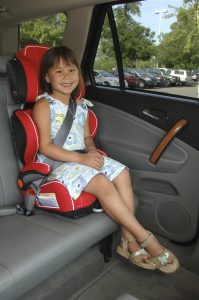Cass County Public Health Offers Free Car Seat Checks
September 22nd, 2021 by Ric Hanson
(Atlantic, Iowa) – Cass County Public Health “Parents as Teachers” is offering free car seat inspections. The inspections will take place this Saturday, September 25th, from 9-until 11-a.m., in the parking lot at the Ann W. Wickman Child Development Center at 703 Linn Street in Atlantic. Please enter by the north drive, off 7th Street. Multiple certified Child Passenger Safety Technicians will be on hand to inspect car seats, help parents install them correctly, give tips about car seat safety, and answer any questions. There is no cost for the inspections, but appointments are needed. Please make an appointment online at cciaph.as.me/carseat or by calling 712-243-7475. 
Here are some tips and points to remember to keep kids in boosters safely and properly secured….
Why Booster Seats are Important:
Keep your growing passenger safe. A booster seat provides a step between a car seat with a harness and a seat belt alone. It boosts the child for a safer and more comfortable fit of the adult seat belt.
Is it time to move to a booster seat? Make sure your child meets the weight or height limits allowed in her forward-facing car seat. The child must also be mature enough to ride without a harness. What does “mature enough” mean? She needs to stay in the booster seat the entire ride with the seat belt properly fitted across the shoulder and below the hips.
Types of Booster Seats
- High back booster. This type is best if your vehicle has a low seat back and no head rest. Like adults, children need support behind their heads. A high-back booster may also be good for younger children who fall asleep in the car.
- Backless booster. This type may be more convenient if you carpool or travel. They are typically less expensive. However, the vehicle must have a seat back high enough to provide support behind your child’s head. What’s high enough? Your child’s ears should be below the top of the vehicle seat or head rest.
The Right Fit for Your Booster Seat

Getting a safe ride. A booster seat lifts a child’s body so the car seat belt can fit properly. The seat belt must lie flat across your child’s chest, is on the bony part of his shoulder and is low on the hips or upper thighs.
Using the seat belt. The booster seat is specifically designed for seat belt fit. Follow the arrows or guides on the booster seat that show you where to place the lap and shoulder belts. This will protect the child’s face, neck and belly. Watch for this common problem. Make sure your child doesn’t put the shoulder belt behind her back or under her arm. If she must do that to be comfortable, it’s best to use a car seat with a harness or a different booster seat with an adjustable shoulder belt guide.
Seat Belt Safety
Don’t be in a hurry. Your child is safer in a booster seat until the adult seat belt fits correctly, usually between the ages of 8 and 12. Do the Seat Belt Fit Test. If your child doesn’t pass every step in the test below, keep him in a booster seat until he does. Test in all the cars your child uses. Remember, just because the seat belt fits your child in one car doesn’t mean the seat belt will fit in all cars. Perform the Seat Belt Fit Test in every car before permanently moving from the booster seat to seat belt only.
The Seat Belt Fit Test
Check knees and feet. Your child’s knees bend at the edge of the seat when her back and bottom are against the vehicle seat back. Her feet should touch the floor for comfort and stability.
Check the lap belt. The vehicle lap belt fits snugly across the hips or upper thighs. Check the shoulder belt. The shoulder belt fits across the shoulder and chest, NOT across the face or neck.





